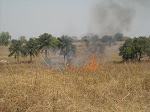February saw the beginning of my least favorite (though aptly named) Beninese season--Chaleur or "Heat." This means that by 10 a.m. the sun's immense power is already bearing down on all of us, slowing everyday life to a crawl as we all sluggishly amble between patches of shade. Wells have dried up to such an extent that the water pulled up is completely opaque with sand and dust. Most men simply lounge under trees all day and alternate between board games and heat-induced comas.
For me the season officially announced itself when one day I walked into the concrete box I call home and instantaneously broke into an all-over body sweat. Now if I stay stationary for too long at home around noon, little puddles of perspiration collect around my feet. This unfortunate situation poses a serious problem when nighttime rolls around and I’d like to get some sleep. Against my will I’m awakened--sometimes three times a night--by the dampness (read: saturation) of my sheets forcing me onto my feet and to the shower to pour water over myself.
It was my Beninese mama who first suggested sleeping on the floor. This worked wonderfully for a few nights (except for a little soreness) until one morning I opened a work folder to discover a pre-historic centipede about four inches long. Her son was later stung by a scorpion who escaped his suffocatingly hot hiding place for just that purpose. I moved back to the bed.
Another village friend advised me to get a cot made. In Benin cots are surprisingly comfortable wood-and-tough-plastic-bag affairs so it seemed like a viable option. I got one and slept on it one night: heaven. On the second night an unfortunate miscalculation in terms of body mass and centers of gravity resulted in the collapse of my cot and a very bruised and hurting elbow. I’ve moved back to the bed.
Though I still haven’t admitted defeat in my efforts to reduce my nightly sweat output, there is definitely a light at the end of the tunnel. Chaleur only lasts until around the beginning of April and then--after months and months--come the rains. And that’s when the best season of all begins: Mango Season.
4 years ago
